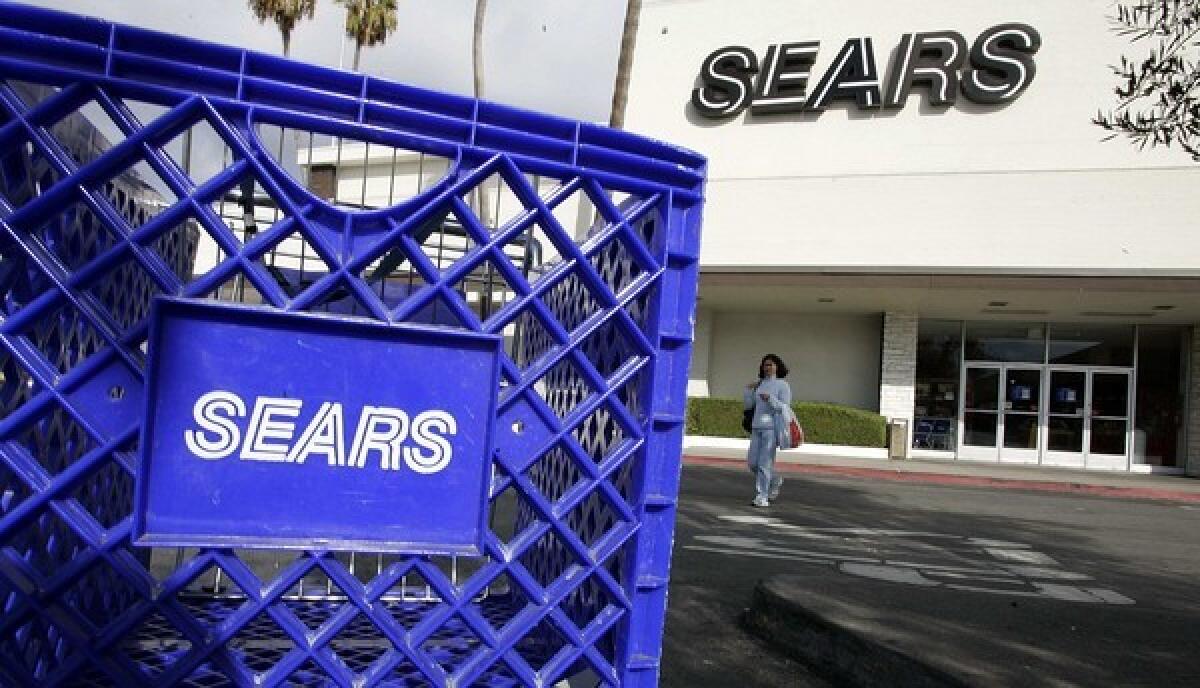Sears and Kmart stores are up for grabs across California. But who wants all that space?

- Share via
Beleaguered American retailers are closing thousands of stores as the COVID-19 pandemic wears on.
Already, a plethora of chains have filed for bankruptcy protection, including jeans brand True Religion, department store chain J.C. Penney Co., home goods retailer Pier 1 Imports Inc. and preppy clothes purveyor J. Crew. Not only are the companies dealing with a changing retail environment that favors e-commerce, they’re also facing a sharp decrease in sales because of the pandemic.
In Southern California, the dwindling number of Sears and Kmart stores are among the latest pushed to the edge.
At least three Kmart stores and 10 Sears locations are listed for lease on the website of commercial real estate services firm JLL. The Kmart stores are in Costa Mesa, Grass Valley and Long Beach. The Sears stores are in Burbank, Boyle Heights, Clovis, Concord, Downey, Pasadena, Sacramento, Stockton and Whittier, and the Sears Auto Center in Orange.
Sears and Kmart parent company Transformco declined to comment on whether the 13 stores were closing. All of the locations were still listed Thursday on Kmart and Sears store locator sites, but the properties are available for rent immediately, which signals that the stores could be quickly closed to make way for new lessees.
Assuming anyone is interested in moving in.
Even before COVID-19 hit, retail real estate owners were struggling to find tenants interested in taking over the massive husks left behind by failing department stores and big box retailers. Malls were trying to cope by capitalizing on customers’ interest in experiences and socialization, rather than just shopping for apparel — large storefronts were seen as prime opportunities for new entrants, such as restaurants or gyms.
But public health concerns over the spread of the coronavirus may put those backup plans on ice. There’s no single answer for what’s to become of the growing number of vacant storefronts.
“As much as we in the industry want to identify the next solution for the mall that is declining, it’s really, really hard to do,” said Todd Caruso, senior managing director at commercial real estate services firm CBRE.
Once a retail powerhouse, Sears has been on a slow decline for years and struggled to adapt to shoppers’ preference for e-commerce over bricks-and-mortar retailers, culminating in its 2018 bankruptcy filing. The company was later purchased out of bankruptcy by Transformco, but it still shed 96 stores at the end of last year. Based in Hoffman Estates, Ill., Transformco is a subsidiary of hedge fund ESL Investments.
Chris Wilson, head of national retail agency leasing at JLL, said his firm was retained by Transformco to serve as an advisor on stores across the country.
The shells of former department stores have been converted to other uses in recent years, including offices for rent, furniture stores, movie theaters and gyms.
“Now you’ve got to ask yourself the question: Will fitness continue being as active as it was post-COVID? Who knows,” Caruso said.
Adding restaurants to malls was a popular option to increase traffic, but it’s hard to project when such socialization and indoor dining will become common again, said Ron Friedman, head of retail and consumer products at Marcum, a public accounting and advisory service firm.
“It depends how long this lasts,” he said.
Vacant department stores have also been divided by mall owners to make way for smaller tenants, such as fast-fashion retailers or discount clothing stores. And some have been razed to make way for new uses, such as housing or healthcare facilities.
Other vacant spaces are being repurposed for industrial use, including last-mile delivery centers.
For example, Amazon is reportedly in talks with mall owner Simon Property Group to take over spaces nationwide that were formerly occupied by Sears and J.C. Penney for use as shipping fulfillment centers.
In a recent report, CBRE projected that this trend would only be accelerated by the recent increase in e-commerce orders driven by coronavirus-related stay-at-home orders.
But not every vacant mall space is the right fit for a logistics warehouse. Developers need to look at the demand in the area, the location and spacing, as well as get necessary approvals, CBRE’s Caruso said.
More to Read
Inside the business of entertainment
The Wide Shot brings you news, analysis and insights on everything from streaming wars to production — and what it all means for the future.
You may occasionally receive promotional content from the Los Angeles Times.











